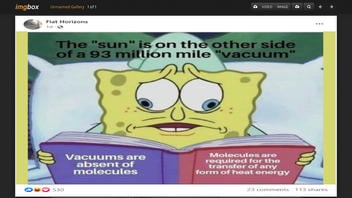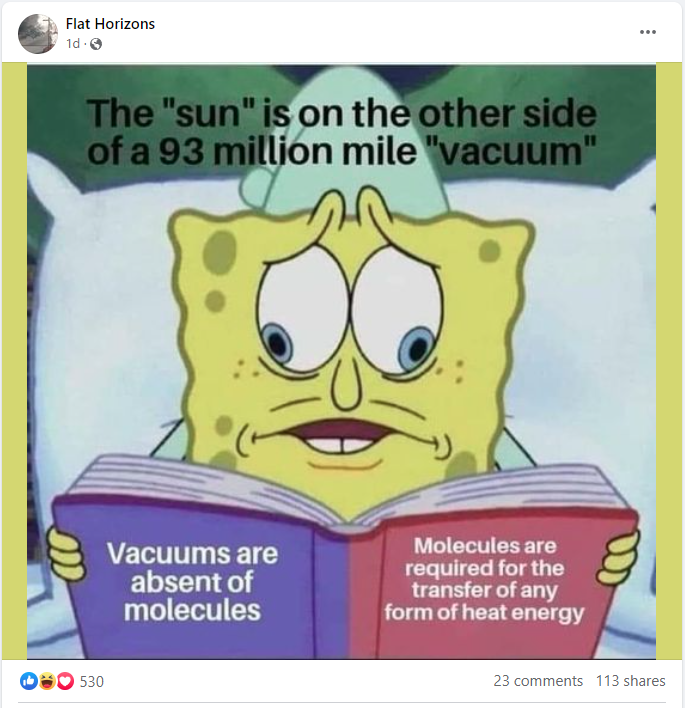STORY UPDATED: check for updates below.

Does the 93-million-mile vacuum separating the Earth from the sun prevent the latter from heating our planet? No, that's not true: A University of California, Berkeley physicist told Lead Stories that the claim is "completely false." The sun's energy is transmitted through electromagnetic radiation, including visible light and infrared radiation, which can travel through space without the need for a physical medium.
The claim appeared in a post on Facebook (archived here) published by Flat Horizons on August 8, 2023, under the title "The 'sun' is on the other side of a 93 million mile 'vacuum.'" The meme also said:
Vacuums are absent of molecules. Molecules are required for the transfer of any form of heat energy.
This is what the post looked like on Facebook at the time of writing:
(Source: Facebook screenshot taken on Wed Aug 9 14:42:39 2023 UTC)
The meme
The SpongeBob SquarePants meme sets up a false logic puzzle in its attempt to imply that the sun's energy doesn't heat the Earth. For the claim to be true, all three parts must be true. Let's look at each one separately:
1. The 'sun' is on the other side of a 93 million-mile 'vacuum'
This statement is true.
The distance between the Earth and the sun varies over the course of each year but averages 93 million miles, according to NASA. The space agency also says, while not a perfect vacuum, space is a better vacuum than scientists can create in a laboratory. So, it's very, very close to being one.
2. Vacuums are absent of molecules
This statement is true.
Britannica.com provides this physics definition:
vacuum, space in which there is no matter or in which the pressure is so low that any particles in the space do not affect any processes being carried on there.
3. Molecules are required for the transfer of any form of heat energy
This statement is NOT true.
In an August 9, 2023, email response, Wick Haxton, a University of California, Berkeley astrophysics professor, responded to the meme's implied claim that the sun can't heat the Earth through a vacuum. He told Lead Stories:
The statement is completely false.
The light emitted from the Sun's surface, representing energy generated in the core of the Sun by the fusion of four protons into helium, travels to Earth through the vacuum of space as photons - quanta of electromagnetic radiation. When you look at the Sun, you see it: which means photons have traveled from the Sun's surface to your eye through the vacuum of space, and are recorded as they hit the retina.
According to Haxton, approximately 99 percent of the energy the sun produces is emitted as this type of light. The remaining 1 percent is emitted as neutrinos, which we can't see as visible light, but can be (and are) detected by massive underground detectors on Earth with great sensitivity, specifically designed for this purpose.
Definitions
Haxton uses a few terms non-scientists might not be familiar with: photons, which he also refers to as "quanta of electromagnetic radiation," and neutrinos. The definitions below are also provided by Britannica.com:
Photons, often referred to as light quanta, are tiny packets of energy in the form of electromagnetic radiation. This concept was first introduced by Albert Einstein in 1905 when he explained the photoelectric effect. Einstein proposed the idea of discrete energy packets to describe how light is transmitted.
A neutrino is an elementary subatomic particle characterized by its lack of electric charge and extremely small mass. Due to their minuscule mass, neutrinos are challenging to measure accurately.
In another August 9, 2023, email, Chris Moore, chairman of the Department of Physics at the University of Nebraska Omaha, told Lead Stories that the claim in the social media post is "not true." He continued:
Heat radiation. The transfer is mediated through electromagnetic waves, which do not need a medium as verified by a famous experiment called the Michelson-Morely experiment.
You can learn more about the Michelson-Morley experiment here. The demonstration from 1887 proved that light waves don't have to travel through anything as do waves in water or sound waves in air.
NASA
C. Alex Young, associate director for science in the Heliophysics Science Division at NASA's Goddard Space Flight Center, also dismissed the notion that the sun can't heat up the Earth through the vacuum of space. In an August 11, 2023, email, he said:
Radiative transfer is when light (electromagnetic waves) transfers the energy to molecules causing them to increase their motion and heat up. Molecules respond to infrared light which we cannot see with your eyes but if you hold your hand up to the sun you can feel it warming up as the infrared light causes the molecules in your hand to move faster (heat up).
An overarching point is that heat is energy of the motion of atoms and molecules.
Because light does not need a medium to travel through it can travel through a vacuum and that is how energy from the sun is carried through space where it then transfers energy to us on Earth. The light from the sun in particular infrared light heats up air molecules radiatively which then transfers the heat around Earth via conduction.
More information
The University of California, Santa Barbara ScienceLine website provides this explanation of how the sun heats the Earth. It says:
The sun heats the earth through radiation. Since there is no medium (like the gas in our atmosphere) in space, radiation is the primary way that heat travels in space. When the heat reaches the earth it warms the molecules of the atmosphere, and they warm other molecules and so on. This heat transfer is called conduction. It also keeps the Earth warm at night when the sun rays are not available. This is in contrast to space where heat can only exist where the heat waves are traveling, leaving huge temperature differences between a place in the sun and a place in the shadow.
A video
Additional information about how the sun heats the Earth can be found in this video from the University of Illinois Extension:
Updates:
-
2023-08-14T15:03:48Z 2023-08-14T15:03:48Z Adds context from C. Alex Young, associate director for science in the Heliophysics Science Division at NASA's Goddard Space Flight Center.















